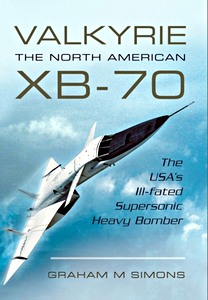Valkyrie - The North American XB-70 - The USA's Ill-Fated Supersonic Heavy Bomber
During the 1950s, at the time the USA was aiming to become the world's only superpower, plans were being drawn at North American Aviation in Southern California for an incredible Mach-3 strategic bomber. The concept was born as a result of General Curtis LeMay's desire for a heavy bomber with the weapon load and range of the subsonic B-52 and a top speed in excess of the supersonic medium bomber, the B-58 Hustler. If LeMay's plans came to fruition there would be 250 Valkyries in the air; it would be the pinnacle of his quest for the ultimate strategic bomber operated by America's Strategic Air Command. The design was a leap into the future that pushed the envelope in terms of exotic materials, avionics and power plants.
However, in April 1961, Defense Secretary McNamara stopped the production go-ahead for the B-70 on grounds of rapid cost escalation and the USSR's new-found ability of destroying aircraft at extremely high altitude by either missiles or the new Mig-25 fighter. Nevertheless, in1963 plans for the production of three high-speed research aircraft were approved and construction proceeded. In September 1964 the first Valkyrie, now re-coded A/V-1 took to the air for the first time and in October went supersonic.
This book is the most detailed description of the design, engineering and research that went into this astounding aircraft. It is full of unpublished details, photographs and first-hand accounts from those closely associated with the project. Although never put into full production, this giant six-engined aircraft became famous for its breakthrough technology, and the spectacular images captured on a fatal air-to-air photo shoot when an observing Starfighter collided with Valkyrie A/V-2 which crashed into the Mojave Desert.
The loss of the $750 million aircraft and two lives stopped future development, although there were several attempts to redesign it as an airliner to compete against the European Concorde.
Detalle del libro
| Autor: | Graham M. Simons |
|---|---|
| Presentación: | 256 páginas, 23.5 x 15.5 cm, tapa blanda |
| Ilustración: | 170 fotos en b/n |
| Editorial: | Pen & Sword Books Ltd (GB, 2014) |
| ISBN: | 9781473822856 |

Valkyrie - The North American XB-70 - The USA's Ill-Fated Supersonic Heavy Bomber
Idioma: Inglés
Disponible en Amazon - pago segura y entrega rápido
Comprar en Amazon ESComprar en Amazon.com







